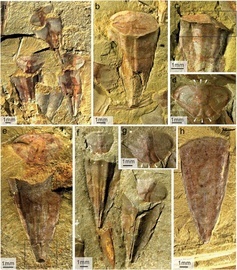Triplicatella opimus: Redescription of a Orthothecid Hyolith from the early Cambrian Chengjiang Lagerstätte.
[sciencythoughts.blogspot.com]
Hyoliths are a group of extinct Palaeozoic marine animals, which possessed distinct conical calcareous shells and range in age from the early Cambrian through to the Permian. The group was one of the first Bilaterians to acquire shells and rapidly became one of the most abundant and cosmopolitan biomineralising animals in Cambrian strata. Hyoliths are subdivided into two distinct groups, Hyolithida and Orthothecida, based on a number of morphological differences. Typical Hyolithids have a four-part external skeleton, including a conical conch with a ligula, an externally fitting operculum, and a pair of curved helens that resemble oars. Orthothecids on the other hand only have two parts, a conch without a ligula and a retractable operculum. Well-preserved Hyoliths with articulated opercula are abundant in the Chengjiang Lagerstätte. Seven species of Hyoliths have been previously recorded; however, these species are difficult to define based on previous descriptions.


Enjoy being online again!
Welcome to the community of good people who base their values on evidence and appreciate civil discourse - the social network you will enjoy.Create your free account
2 comments
Feel free to reply to any comment by clicking the "Reply" button.Recent Visitors 15
Photos 292 More
Posted by JoeBKite-like structures in the western Sahara Desert.
Posted by TriphidAn Aussie Indigenous Message Stick.
Posted by TriphidIndigenous Australian Aboriginal Rock art dated somewhere between 20 and 30 thousand years old.
Posted by TriphidIndigenous Australian Aboriginal Rock art dated somewhere between 20 and 30 thousand years old.
Posted by TriphidIndigenous Australian Aboriginal Rock art dated somewhere between 20 and 30 thousand years old.
Posted by TriphidIndigenous Australian Aboriginal Rock art dated somewhere between 20 and 30 thousand years old.
Posted by JoeBDortoka vremiri: A new species of Dortokid Turtle from the Late Cretaceous of the Hațeg Basin, Romania.
Posted by JoeBThe Cabeço da Amoreira burial: An Early Modern Era West African buried in a Mesolithic shell midden in Portugal.
Posted by JoeBMusivavis amabilis: A new species of Enantiornithine Bird from the Early Cretaceous Jehol Biota of northeastern China.
Posted by JoeBTorosaurus in Canada.
Posted by JoeBStone tools from the Borselan Rock Shelter, in the Binalud Mountains of northeastern Iran.
Posted by JoeBDating the Lantian Biota.
Posted by JoeBBashanosaurus primitivus: A new species of Stegosaur from the Middle Jurassic of Chongqing Municipality, China.
Posted by JoeBDetermining the time of year when the Chicxulub Impactor fell.
Posted by JoeBSão Tomé and Príncipe: Possibly the last country on Earth never to have been visited by a working archaeologist.
Posted by JoeBMambawakale ruhuhu: A new species of Pseudosuchian Archosaur from the Middle Triassic Manda Beds of Tanzania.






